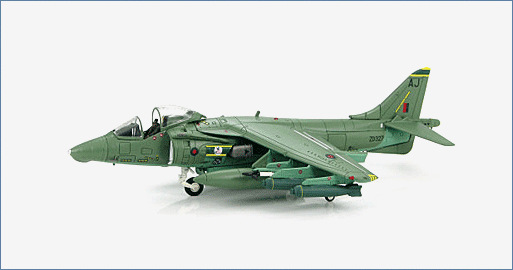Air Power Series>1:72 die-cast display model>Harrier>HA2615
GR.5 Harrier ZD327 "AJ" RAF 3 Sqn., Gutersloh, Germany 1990

General Background
The Harrier is the first operational V/STOL (Vertical/Short Takeoff and Landing) aircraft. By directing the engines exhaust through movable nozzles the force could be used to propel the aircraft along a runway or lift it vertically and then into a forward motion. Because of this ability to lift off vertically the Harriers began to be referred to as “jump jets”. These aircraft were continuously being refined and improved over the years with many new variants being produced.
The Aircraft
RAF No. 3 Squadron was formed on May 13, 1912 and was the first RAF squadron to receive the new flying machines. The squadron’s first encounter with the Harrier was in early 1970 when they received GR.1’s. In 1977 No.3 Squadron were stationed at RAF Station Gütersloh, West Germany where they acquired the GR. 3 and the GR. 5. In 1992 No. 3 Squadron moved to RAF Station Laarburch, on the German border with the Netherlands, now flying the GR.7 Harrier. In 1997 they returned to RAF Station Cottesmore.
Specifications :
| Crew: | 1 |
| Dimensions | |
| Length: | 46 ft 4 in (14.12 m) |
| Height: | 11 ft 8 in (3.56 m) |
| Wingspan: | 30 ft 4 in (9.25 m) |
| Wing area | 343 ft² (22.6 m²) |
| Weights | |
| Empty: | 12,500 lb (5,700 kg) |
| Loaded: | 15,703 lb (7,123 kg) |
| Maximum Takeoff : | VTO 18,950 lb (8,595 kg) |
| STO 31,000 lb (14,016 kg | |
| Powerplant | |
| Engines: | 1× Rolls-Royce Pegasus Mk. 105 turbofan with four thrust vectored exhaust nozzles, 21,750 lb (96.7 kN) |
| Performance | |
| Maximum speed: | 662 mph (1,065 km/h) |
| Combat radius: | 300 nmi (556 km) |
| Ferry range: | 2,015 mi ( 3,242.8 km ) |
| Service ceiling: | 50,000 ft (15,000 m) |
| Rate of climb: | 14,715 ft/min (74.8 m/s) |
| Armament | |
| Guns | 2 × 30 mm (1.18 in) ADEN cannon pods under the fuselage |
| Hardpoints | 8× under-wing pylon stations holding up to 8,000 lb (3,650 kg) of payload |

